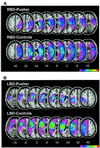The neural representation of postural control in humans
- PMID: 11087818
- PMCID: PMC17678
- DOI: 10.1073/pnas.240279997
The neural representation of postural control in humans
Erratum in
- Proc Natl Acad Sci U S A 2001 Jan 16;98(2):777
Abstract
Lesion of the "vestibular cortex" in the human posterior insula leads to a tilted perception of visual vertical but not to tilted body posture and loss of lateral balance. However, some stroke patients show the reverse pattern. Although their processing of visual and vestibular inputs for orientation perception of the visual world is undisturbed, they push away actively from the ipsilesional side (the side of lesion location), leading to a contraversive tilt of the body (tilt toward the side opposite to the lesion) and falling to that side. Recently, the origin of contraversive pushing was identified as an altered perception of the body's orientation in relation to gravity. These patients experience their body as oriented "upright" when actually tilted enormously to the ipsilesional side (18 degrees on average). The findings argued for a separate pathway in humans for sensing body orientation in relation to gravity apart from the one projecting to the vestibular cortex. The present study aimed at identifying this brain area. The infarcted brain regions of 23 consecutively admitted patients with severe contraversive pushing were projected onto a template MRI scan, which had been normalized to Talairach space. The overlapping area of these infarctions centered on the posterolateral thalamus. Our finding necessitates reinterpretation of this area as being only a "relay structure" of the vestibular pathway on its way from the brainstem to the vestibular cortex. The ventral posterior and lateral posterior nuclei of the posterolateral thalamus (and probably its cortical projections) rather seem to be fundamentally involved in the neural representation of a second graviceptive system in humans decisive for our control of upright body posture.
Figures


References
-
- Perry J. Clin Orthop. 1969;63:23–31. - PubMed
-
- Brunnstrom S. Movement Therapy in Hemiplegia: A Neurophysiological Approach. New York: Harper & Row; 1970.
-
- Bohannon R W, Cook A C, Larkin P A, Dubuc W E, Smith M B, Horton M G, Hypes C. Neurol Rep. 1986;10:43–44.
-
- Davies P M. Steps to Follow: A Guide to the Treatment of Adult Hemiplegia. New York: Springer; 1985.
Publication types
MeSH terms
LinkOut - more resources
Full Text Sources
Medical

